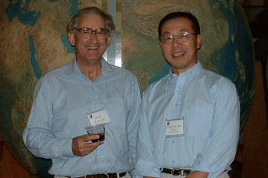
@@@
@

|
@
@Coming from the Institute of Theoretical and Applied Geophysics (ITAG) at Peking University, China I will spend four months from 1 April 2004 in Matsuyama as a visiting professor of GRC. I graduated from the geophysics program at the University of Science and Technology of China in 1982. One year later I went to Princeton University, USA as a graduate student. Advised by Professor W. Jason Morgan, I received my Ph.D. in geophysics at Princeton University in April 1989. Afterwards, I spent less than two years as a Green Scholar (postdoc) at the IGPP, Scripps Institution of Oceanography, UCSD, USA before I joined the geophysics faculty at Oregon State University, USA in January 1991. I had served as an associate editor of Journal of Geophysical Research (JGR) during 1996-1999. I recently accepted an invitation to become Co Editor in Chief of Marine Geophysical Researches ("MARI"), next to Dr. Peter Clift at WHOI, USA.
@My principal research interests are in the plate boundary processes at
both mid-ocean ridges and subduction zones. Using numerical modeling as
a tool, I have published most of my research works on mid-ocean ridge processes
including dynamic rifting and the resulting ridge topography and the construction
of new oceanic crust at the ridge axes. I and others developed the current
ridge thermal models, which has had strong impact on ridge related researches
for the past decade. These models were often used for designing field experiments
and were continuously tested against new findings from research cruises.
@I moved to Beijing in 2002 and took a "Chang Jiang" professorship
and director position at the ITAG, Peking University. This important career
move enabled me to expand my research interests from marine to continental
tectonics, especially large-scale deformation of the Asian continent and
its margin along the east coast. Starting May 2004 our research team with
16 broadband seismometers of ITAG, Peking University will join the on-going
Hi-CLIMB field experiment in southern Tibet. The Hi-CLIMB is the acronym
for an international, multi-disciplinary, integrated study of the Himalayan-Tibetan
continental lithosphere during mountain building, and it involves scientists
from US, French, China, and Taiwan.
@The main reason I come to GRC at the time of Sakula blooming is to work on a project of developing numerical models for the Japan subduction system with a strong focus on the convection in the mantle wedge above the subducted slab, in collaboration with Professor Dapeng Zhao at the Seismological Laboratory of GRC, Ehime University.
@During my four months visit, I plan to investigate the thermal and flow
structures of a dynamic mantle wedge above a slab using a numerical modeling
approach. Taking the well-studied Japan subduction zone as a case study,
I want to test the current hypotheses of how does a subducting system operate.
For example, one focus of the modeling effort will be devoted to understanding
the effects of the hydrous phases released from the subducted oceanic crust
on the melting of the mantle wedge. The size and the location of the predicted
melting region will be compared with the detailed seismic tomographic results
and the arc volcanisms on the Japan Islands.
@On a personal note I have a relatively large family according to the
current standard with two sons, Peter (17) and Jack (3), and one daughter,
Diana (12). My wife, Dr. Lihua Zhang, a Ph.D. (99) in geochemistry from
Oregon State University, is currently working at an environmental company
in New Jersey, USA. Each year I joined my family in the US during the two
vocation seasons, one in the summer and one in the winter. While in the
US, the most exciting adventures of our family are the camping trips to
remote mountains or lakes such as the trip to Maine, the northeastern state
of the US, in the summer of 2003, where we all had the closest contact
with nature.

©@Back
@ Yongshun John Chen
@ iOl€υiqυjj
